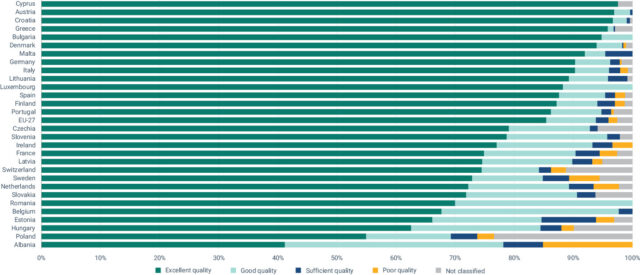
On a hot summer day, nothing beats swimming in a sea, lake or in a river (cold beer comes close, though). If the urge to swim hits when you are traveling in Europe, which countries are managing their environment so that designated bathing waters have remained clean? European Environment Agency (EEA) has the answer: the island state of Cyprus in the Mediterranean Sea has the cleanest coastal waters.
The conclusions from the EEA European bathing water quality in 2023 report are that the overall water quality is good. 96% of water measured in bathing sites met the minimum quality standards, and 85% of bathing waters were rated excellent in quality. Sea water has somewhat better quality than inland water.
Here are the top 14 European countries where bathing waters are the cleanest (as far as the amount of bacteria is concerned) as reported by EEA:
- Cyprus
- Austria
- Croatia
- Greece
- Bulgaria
- Denmark
- Malta
- Germany
- Italy
- Lithuania
- Luxembourg
- Spain
- Finland
- Portugal
The listed 14 countries are above the EU average when it comes to the cleanliness of bathing water. The rest of the EU countries, plus Switzerland and Albania are below the average. Waters in Albania were the most polluted – by a large margin compared to other European countries.
Naturally, the EEA can’t measure all the millions of beaches and other places where people enjoy swimming in Europe. For instance, only in Nordic countries there are hundreds of thousands of lakes and rivers with hundreds of thousands of saunas by the sea and lakes with places to swim. In any case, the measured numbers indicate where environment in general has been protected.
EEA says its assessment covered 22,081 bathing waters in Europe that were reported to the EEA for the 2023 season. How does the measurement actually work? EEA collects data from local and national authorities who: “take samples from bathing waters and analyse them for the two types of bacteria (E. coli and intestinal enterococci) that are indicative of pollution from sewage and manure. Based on the levels of bacteria detected, bathing water quality is then classified as either ‘excellent’, ‘good’, ‘sufficient’ or ‘poor’. Polluted water can, if swallowed, impact human health, causing stomach upsets and diarrhea. Infections of the ears, eyes and upper respiratory tract are also possible.”
You may have seen advertisements for beaches that have been awarded a Blue Flag as a sign of environment-friendly, safe and accessible site. The foundation that runs the Blue Flag program rates beaches, marinas, and boats at this page.

